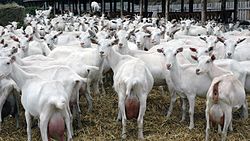 Nanny on the Engstligenalp | |
| Conservation status | FAO (2007): no concern [1] |
|---|---|
| Other names | |
| Country of origin | Switzerland |
| Distribution | worldwide |
| Standard | |
| Use | milk |
| Traits | |
| Weight | |
| Height | |
| Skin colour | white |
| Coat | short, smooth |
| Hair colour | white |
| Face colour | white |
| Horn status | horned or hornless |
| |

The Saanen [a] is a Swiss breed of domestic goat. It takes its name from the Saanental in the Bernese Oberland, in the southern part of the Canton of Bern, in western Switzerland. It is a highly productive dairy goat and is distributed in more than eighty countries worldwide. [3]